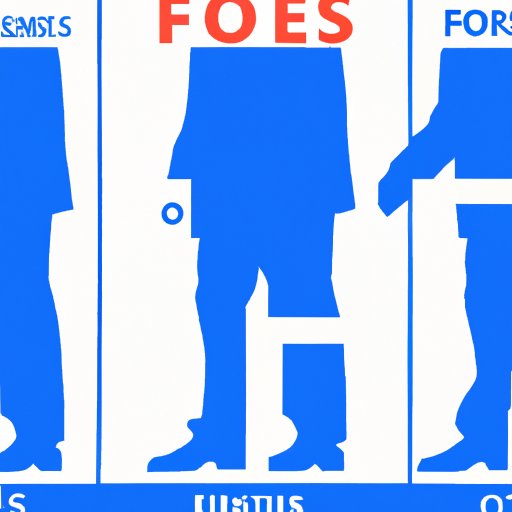Introduction
Fear is a powerful emotion that can have a significant impact on human behavior. It has been used throughout history to manipulate people into making decisions they would not otherwise make. This article will explore how fear can be used to manipulate people, examining the psychology of fear, its role in advertising, politics, the workplace, and social movements.

Examining the Psychology of Fear: How It Can Be Used To Manipulate People
Understanding the role of emotions in decision making is key to understanding how fear can be used to manipulate people. Human beings are driven by their emotions, and fear can be a powerful motivator. Fear can be used to convince people to act in ways they might not normally act or to make decisions they would not normally make, such as buying a product or voting for a particular candidate.
There are several different types of fear-based manipulation. Fear of loss is one of the most common forms of manipulation. This type of manipulation involves using fear of losing something, such as money or status, to convince someone to take a certain action. Fear of punishment is another type of manipulation, which involves using fear of consequences to persuade someone to do something. Finally, fear of the unknown is also commonly used to manipulate people, as it can be used to create uncertainty and doubt.
The effects of fear on human behavior can be profound. Fear can cause people to become irrational, overreact, and make decisions based on emotion rather than logic. Fear can also lead to a feeling of helplessness, causing people to feel overwhelmed and unable to make decisions. In extreme cases, fear can even lead to paralysis, where people become so afraid of taking any action that they simply freeze.
Exploring the Power of Fear-Based Advertising: Using Fear to Influence Buyer Decisions
Fear-based advertising is a common marketing tactic used to influence consumer behavior. By using fear to tap into people’s emotions, advertisers can create an emotional connection with their audience and convince them to buy their product. Fear-based advertising can be effective, but it must be used carefully, as it can backfire if used too aggressively.
Analyzing examples of fear-based advertising strategies can help to understand how this tactic works. For example, advertisements that use fear of missing out (FOMO) to drive sales often feature limited time offers or limited availability of a product. This creates a sense of urgency and encourages people to act quickly to avoid missing out. Another common fear-based advertising strategy is to use fear of danger or harm to promote a product, such as a safety device or security system.
Investigating the impact of fear-based advertising on consumers can help to understand how effective this tactic is. Studies have found that fear-based advertising can be effective in influencing consumer behavior, as it can create an immediate reaction and encourage people to take action. However, it can also be off-putting and alienate potential customers if used too aggressively.
Evaluating the ethics of fear-based marketing is also important. While fear-based advertising can be effective, it can also be unethical if it misleads or exploits people’s fears. Advertisers should use caution when using fear-based tactics and ensure that their messaging is truthful and ethical.

Analyzing Political Campaigns and Fear Tactics: How Politicians Use Fear To Secure Votes
Politicians often use fear-based rhetoric and tactics to secure votes. Fear can be a powerful political tool, as it can motivate people to support a particular candidate or issue. Fear-based political messaging can be effective, but it must be used carefully to avoid turning off potential voters.
Examining the use of fear-based rhetoric in political campaigns can help to understand how this tactic works. Politicians often use fear to stoke public anxiety about certain issues, such as crime or immigration, and use this anxiety to rally support for their policies. They may also use fear to attack their opponents, painting them as dangerous or untrustworthy.
Analyzing the effectiveness of fear-based political messaging can help to understand how effective this tactic is. Studies have found that fear-based messages can be effective in influencing voter behavior, as they can create an immediate reaction and encourage people to take action. However, fear-based messages can also be off-putting and alienate potential voters if used too aggressively.
Assessing the impact of fear-based politics on voter behavior is also important. Fear-based messages can be effective in influencing voter behavior, but they can also lead to polarization and division if used too aggressively. It is important for politicians to use fear-based messages responsibly, as they can have a long-term impact on public opinion.

Understanding the Impact of Fear in the Workplace: How Leaders Can Use Fear to Control Employees
Fear is often used as a management tool in the workplace. Fear can be a powerful motivator, as it can encourage people to take action and comply with instructions. However, it can also be damaging if used too aggressively, as it can lead to feelings of stress, anxiety, and helplessness.
Investigating the use of fear as a management tool can help to understand how this tactic works. Leaders may use fear to motivate employees to work harder or faster, or to ensure compliance with company policies and procedures. They may also use fear to punish employees who fail to meet expectations or to discourage dissent.
Examining the consequences of fear-based leadership can help to understand how effective this tactic is. Fear-based leadership may be effective in the short term, as it can encourage people to take action and comply with instructions. However, it can also have negative long-term consequences, such as decreased morale, decreased productivity, and increased turnover.
Assessing the effectiveness of fear-based motivation is also important. Fear can be a powerful motivator, but it can also lead to feelings of stress and anxiety if used too aggressively. Leaders should use caution when using fear to motivate employees, as it can have a long-term impact on their performance.
Investigating the Role of Fear in Social Movements: How Activists Use Fear to Mobilize Supporters
Fear is often used in social movements to mobilize supporters and pressure governments to take action. Fear-based narratives can be powerful tools for activists, as they can create an emotional connection with their audience and encourage them to take action. However, fear-based narratives can also be off-putting and alienate potential supporters if used too aggressively.
Examining the use of fear-based narratives in social movements can help to understand how this tactic works. Activists often use fear to highlight the dangers of inaction, creating a sense of urgency and motivating people to take action. They may also use fear to attack their opponents, painting them as dangerous or untrustworthy.
Analyzing the effects of fear-based advocacy can help to understand how effective this tactic is. Studies have found that fear-based advocacy can be effective in influencing public opinion, as it can create an immediate reaction and encourage people to take action. However, it can also be off-putting and alienate potential supporters if used too aggressively.
Evaluating the impact of fear-based activism on public opinion is also important. Fear-based activism can be effective in influencing public opinion, but it can also lead to polarization and division if used too aggressively. It is important for activists to use fear-based messages responsibly, as they can have a long-term impact on public opinion.
Conclusion
Fear is a powerful emotion that can have a significant impact on human behavior. It can be used to manipulate people into making decisions they would not normally make, from buying products to voting for politicians. Fear can also be used to control employees and mobilize supporters in social movements. It is important to understand how fear can be used to manipulate people and the consequences of using fear too aggressively.
(Note: Is this article not meeting your expectations? Do you have knowledge or insights to share? Unlock new opportunities and expand your reach by joining our authors team. Click Registration to join us and share your expertise with our readers.)
